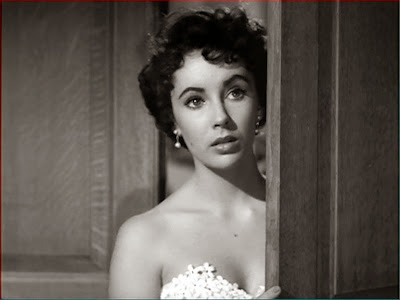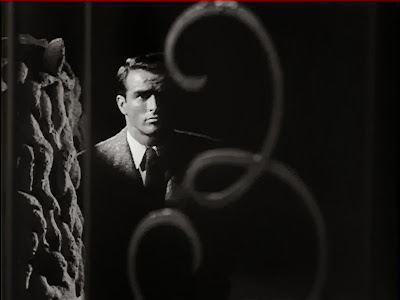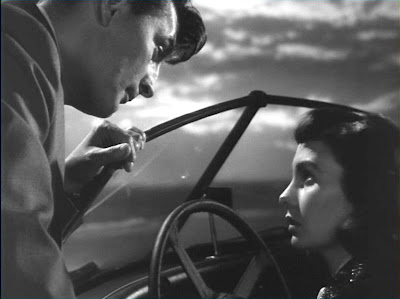“Life
is never quite interesting enough, somehow. You people who come to the movies
know that.” Shirley
Booth as Dolly Levi in The Matchmaker (1958)
No truer words were ever spoken on the topic of what movies
mean to us “dreamers.” I, like a great many film buffs (and as the title of
this blog reiterates), am a dyed-in-the-wool dreamer. And for as long as I can
remember, the allure of motion pictures for me has been their intrinsic link to the
fundamental human need to dream, to long for, to imagine, to aspire to, and to
hope.
Because
I’m essentially an impractical, head-in-the-clouds fantasist for whom dreams
have often proved a contradictory source of my greatest joys and deepest sorrows; I've always been intrigued by the curiously dual nature of dreaming. Dreams are inarguably at the root of all human ambition and invention, possessing the power to ease spiritual pain by way of escapism, inciting creativity, and spurring on the imagination to all manner of human achievement. Yet
at the same time, dreams are equally prone to sowing seeds of dissatisfaction...fostering discontent and delusion when they create a hunger and desire for
things that can never be attained.
When I think about it, a great many of my favorite novels seem to be about the pernicious nature of idealism and dreams: F. Scott Fitzgerald’s The Great Gatsby, Gustave Flaubert’s
Madame Bovary, Nathanael West’s The Day of the Locust, and,
apropos of this post, Theodore Dreiser’s Sister Carrie and An
American Tragedy. Dreiser being specifically
the author I find to be the most compelling purveyor of narratives sensitive to
the healing/hurtful siren song that is the myth of The American Dream.
 |
| Montgomery Clift as George Eastman |
 |
| Elizabeth Taylor as Angela Vickers |
 |
| Shelley Winters as Alice Tripp |
A Place in the Sun is the story of George Eastman (Clift), the poor-relation nephew of pillar-of-society industrialist Charles Eastman, who flees a dead-end
bellhop job in Chicago to be taken on as a worker in his uncle’s bathing suit
factory. George is haunted by his stiflingly poor, rigidly religious
upbringing, and is driven—to an almost pathological degree—to overcome the
limitations of his meager education and humble origins. Applying considerable
initiative toward his ambitions (evinced by his taking home-study courses and
devising plans for factory efficiency in his spare time) George appears at first resigned, albeit restlessly, to work hard for his modest piece of the American Dream. But
as bedeviled as George is about his impoverished past, it soon becomes clear that he is
equally consumed with the desire for the kind of brass ring life his Eastman
lineage dangles teasingly just beyond his grasp.
 |
| Locked Out George Eastman stands dejectedly outside the gate of his uncle's estate, Charles Eastman. The large, ornamental "E" on the gate serving as a caustic reminder of a birthright denied |
Ultimately, fate deals George an ironically cruel hand when the realization of all of his ambitions and dreams become certainties (his professional advancement and social acceptance coincide with a blossoming romance with the beautiful and glamorous socialite, Angela Vickers [Taylor]) at the very moment news of his impregnation of Alice, the plain-but-sweet factory co-worker (Winters) just as certainly signals the end to all he has ever hoped for.
While An American Tragedy (both the novel and the original 1931
film, which is said to be the most faithful adaptation) posit George’s dilemma
within the parameters of a sociopath’s conundrum: George, not feeling much of
anything for either girl, weighs the most selfishly advantageous outcome and
plots to rid himself of the problematic pregnant girlfriend. A Place in the
Sun’s intentionally romanticized construct encourages the viewer to sympathize/identify with George’s predicament. A device that ultimately (and
provocatively) implicates us in the tragic turn of events as they play out.
 |
| "The reason they call it 'The American Dream' is that you have to be asleep to believe it."
George Carlin
|
Theodore Dreiser's pre-Depression era novel An American Tragedy sought to address the accepted American belief that hard work equaled affluence and advancement in a country where nepotism, bloodlines, and arbitrary class/social hierarchies impose distinct limitations. A Place in the Sun uses the false promise of post-war American prosperity as the bait that lures dreamers like George Eastman into believing "the good life" is his for the taking.
WHAT I LOVE ABOUT THIS FILM
A common complaint leveled at A Place in the Sun is that the tension of the film’s central
conflict is significantly weakened in having the drab and ultimately annoying Shelley
Winters character rendered as such a blatantly unappealing option to the
dream-girl perfection of Elizabeth Taylor. The implication being, I suppose, is
that if given the opportunity, anyone in his right mind is going to try to
drown the sympathetic but whiny Winters if it will help land them the exquisitely
beautiful, sweet-natured (and let’s not forget, loaded) Elizabeth Taylor. If
that’s true, what does that say about us?
The near-identical beauty of Montgomery Clift and Elizabeth Taylor emphasizes their compatibility
|
Therein lies my fascination with A Place in the Sun. Instead of turning Dreiser’s novel into just another
crime story with a social commentary overlay, George Stevens—drawing upon the
entire arsenal of cinematic devices that helped give Hollywood its reputation as
America’s “Dream Factory”—idealizes the tale and subtly seduces, making us complicit
allies in George’s social-climbing fantasies. He structures the film as an
unabashedly romanticized, male Cinderella fairy tale about “fated to be mated” lovers
threatened by the ugly specter of poverty and deprivation. The latter is embodied
by the likable but difficult-to-root-for Shelley Winters.
With every lovingly-photographed close-up of the impossibly beautiful couple…with every lushly orchestrated romantic idyll captured in passionate tableau…we’re not only encouraged to project our fantasies onto the idealized couple, but to see them as sympathetic souls deserving of having their dreams come true. Something not possible without vilifying the story’s real victim (Winters) as the sole obstacle to their happiness.
With every lovingly-photographed close-up of the impossibly beautiful couple…with every lushly orchestrated romantic idyll captured in passionate tableau…we’re not only encouraged to project our fantasies onto the idealized couple, but to see them as sympathetic souls deserving of having their dreams come true. Something not possible without vilifying the story’s real victim (Winters) as the sole obstacle to their happiness.
The genius of A Place
in the Sun, and why I consider it to be a minor masterpiece, is how,
through the juxtaposition of appealing images of wealth and dreary images of
poverty, the audience, when faced with the issue of what to do about the blameless
but problematic Shelly Winters character, are placed in the same morally
ambiguous position as Montgomery Clift.
PERFORMANCES
Only two of the 9 Oscar nominations A Place in the Sun garnered in
1951 were in the acting categories: Best Actor, Montgomery Clift, and Best Actress Shelley Winters (it won a whopping 6 awards, including Best Director for
Stevens). The always-impressive Clift brings a heartbreaking vulnerability to
what I think is one of his best screen performances. At no moment do you ever
feel he is being moved forward by the plot. You can see every thought and
motivation play out on his face.
On A Place in the Sun’s
DVD commentary track, much is made of the fact that in taking on the role of
the mousy Alice Tripp, blond bombshell Shelley Winters astounded audiences by
so playing against type. Winters is, indeed, very good, but if you’re like me
and largely unfamiliar with the work of Shelley the sexpot, her role feels right in step with characters she played in a great many of her latter films (1955s The Night of the Hunter comes to mind), and thus her performance doesn't feel like the huge departure it perhaps once did.
If your goal is to make plausible the notion that an otherwise sane man would resort to murder for the love of a woman, you're definitely on the right track if that woman is then 17-year-old Elizabeth Taylor. What a knockout! Overlooked by the Academy, her performance in A Place in the Sun is rather remarkable. She gives a surprisingly mature performance—one of her best, in fact—proving to be particularly effective in her later scenes. Taylor would work again with director George Stevens in Giant (1956), and the truly bizarre misfire, The Only Game in Town (1970).
THE STUFF OF FANTASY
My deep affection for A Place in the Sun extends to the way it uses romantic imagery to convey the illusory allure of desire and longing. And by illusory allure, I mean that dreams are only pleasant when they hold out the possibility of coming true. To want for something you can't have tears you apart.
 |
| George is frequently photographed surrounded by idealized images of success and wealth |
 |
| Like the beckoning light on Daisy's dock in The Great Gatsby George studies high school classes under the flickering neon reminder of the Vickers family fortune |
(Above) "Ophelia", John Everett Millais' mid-19th Century painting depicting the drowning death of Shakespeare's heroine, looms ominously over George's head (below) as he ponders: how do you solve a problem like Alice Tripp?
THE STUFF OF DREAMS
A Place in the Sun is one of those rare screen adaptations of a beloved book that captures the author's intent even though it plays fast and loose with the original text. Theodore Dreiser's 1925 novel was turned into a Broadway play in 1926, and a film by Josef von Sternberg in 1931 (for which it is said Dreiser didn't care). Screenwriters Michael Wilson and Harry Brown adapted the 1951 film, and while faithful adaptations are fine, I love when collaborators are able to stay true to the feel of an artist's work, even when its superficial form has been altered. George Stevens has created a forcefully cinematic film that tells its story with a language all its own. It's beautiful to look at, wonderful to listen to (the Franz Waxman score is a real highlight), and boasts a slew of first-rate performances. It's a near-perfect film.
Near perfect...
Near perfect...
Although Raymond Burr, cast as the prosecuting attorney, is actually fine (I guess. It's the same performance he's given for decades), his close association with the Perry Mason character proves a big distraction to me. When he shows up, this absolutely breathtakingly engrossing romantic drama suddenly becomes a TV program.
Similarly, and due to no fault of the actor himself, the casting of Paul Frees as the priest during the film's pivotal final minutes just sticks in my craw. Why? Because as I child, I watched Walt Disney's Wonderful World of Color on TV for years. Anyone familiar with the show will recognize Frees' distinctive voice as the narrator of a million Disney documentaries. And as he is also the voice of the Ghost Host at Disneyland's Haunted Mansion, every time he speaks I'm thrust out of the narrative. Frees' voice is waaaay too hardwired with Disney associations to work on any level for me. Given that he's also the voice of animated no-goodnick Boris Badenov (whom I adore), I suppose I should just be thankful Frees never resorts to speaking in a Pottsylvanian accent.
Watching A Place in the Sun is an immensely pleasurable experience that satisfies no matter what aspect of its story you choose to focus on: the romance, the social commentary, the crime drama, or, my personal preference, the melancholy discourse on the failings of the American Dream. If you haven't seen A Place in the Sun in a while, it's definitely worth another look. If you've never seen it before, well, prepare to be swept away. I am...every time I see it.
Copyright © Ken Anderson 2009 -2013






















































